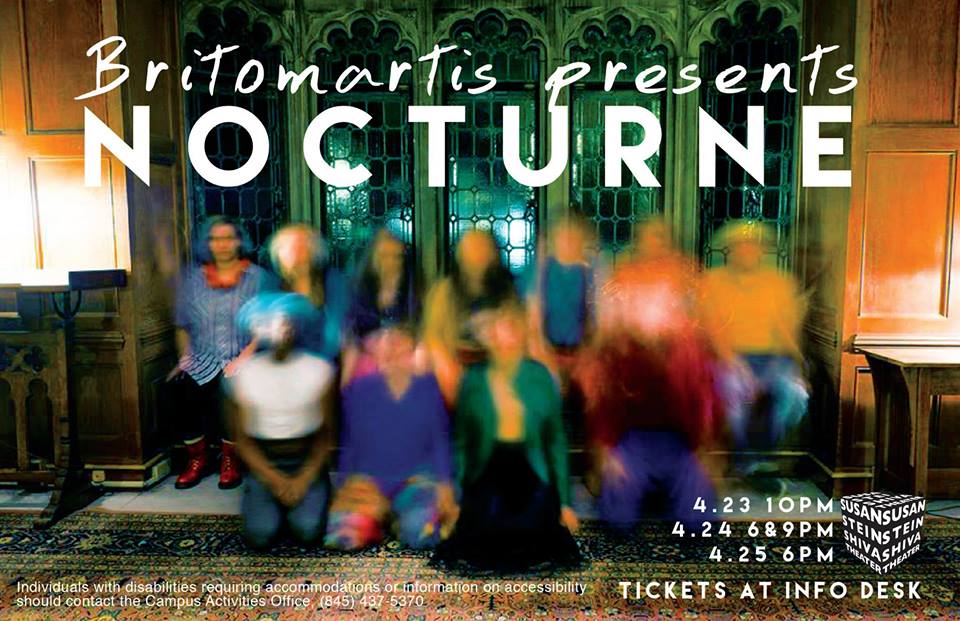Beginning of the Spring semester, Britomartis had a meeting to plan the spring production. It is commonly known, as Derek Butterton has explained to us freshly inducted Britomartians, that every show is a reaction to the last. During the fall we presented Vile Bodies, a devised piece with Evelyn Waugh’s novel by the same name as source text. It was staged in Rocky, and happened in three separate spaces simultaneously. It was quite frankly one of the most ambitious and hectic productions I’ve been a part of, and doing it was a blast. When ideas started to float in the space regarding our next quest, I was immediately drawn to dreams. I’d been thinking about them a lot–mostly in their ambiguity and their potential access to unconventional images and recurring spaces. After much conversation, we came together and chose Oneiros, a dream proposal, as a concept to explore.
We were excited to make a conscious effort to access our unconscious minds–whatever that looked or felt like for each of us; to make of the process something intricate and difficult. To really dig deep and only synthesise the information until we were ready to put it into a show. Like this, the works we did informed each other–tangibly or abstractly, and we were in constant creative cultivation. We worked with objects, mementos, our bodies, anecdotes and images that seemed pedestrian and turned into something else. We could see something private in the public psyche and vice versa. In exploring these dreamscapes, we negotiated distances to reality and thought about a play of proportions, both physical and emotional.
Over spring break some of us kept a dream journal of sorts. I visited my brother upstate, and during the train ride thought about the daydreams I entertain in. I figured that if remembering my night dreams became difficult, I could attempt to amplify my self-awareness when my mind drifted off during my waking hours. Over the course of my visit, I sat down each night and recorded the words that stuck in my mind from the day’s interactions, or the found images that I somehow preserved. It felt like when you have to record a dream right after you wake up–only I recorded these daydreams right before going to bed. It looked something like this.
 The thing about dreams is that we all have them, and tend to lose grip of them so quickly. We witness or participate in scenes that are nonsensical or disturbing, a weird sort of fantasy. In doing this show I had to fight back my urge to dissociate from the strange occurrences of our minds and try to learn from this different way of knowing. To have fun with the oscillation between having complete control or losing it–to hold on to feelings with a changed kind of awareness.
The thing about dreams is that we all have them, and tend to lose grip of them so quickly. We witness or participate in scenes that are nonsensical or disturbing, a weird sort of fantasy. In doing this show I had to fight back my urge to dissociate from the strange occurrences of our minds and try to learn from this different way of knowing. To have fun with the oscillation between having complete control or losing it–to hold on to feelings with a changed kind of awareness.
Instead of neglecting the absurdity of the material we brought in, we found engaging with it took us to unscripted places. We could incorporate nonsensical speech, or awkward movement, or aesthetically compelling images without considering staying true to anything but ourselves. And trusting our choices, even our unconscious ones, was exhilarating. This is how much of the show was built. We delved into language, in-betweenness, religion, love, anxiety. One night Kevin Ritter and I sat down and wrote a story about a girl who got stood up, and upon waiting for her date is struck by six of the ten plagues. Another day we created a tidal dance with the movement of a paper fortune teller. Gabi Mintz wrote a beautiful piano monologue using predictive text on her phone: we wrote a scene of Wiccan prayer and staged an a capella performance of Taylor Swift’s Blank Space.
Oneiros, or Oreos–as it came to be commonly known, turned into Nocturne. Its unconscious narrative was pieced together from fragments following the distinct stages of sleep cycles. The set turned into a vault of thresholds: frames hanging and moving in space like portals into the different levels of consciousness we interacted in. Some scenes snapped abruptly into others, while a number of transitions remained ambiguous. The vignettes, though at first independent, became intertextually referential and a beautiful discourse emerged. Staged in the round, there was no concealment of the elements and the bodies were at all times present; observable, and in alternating degrees of awareness.
Nocturne for me was an intense, intimate exposure of the arresting feelings, people, and places that are made manifest through dreams. It allowed me to indulge in the uncanny, to abridge the distance between audience and performer, sleep and wake. The show encourages us to make ourselves vulnerable to the ways our minds work, to become receptive to bent realities everywhere. That things as ungraspable as dreams need not be transient–that lucidity is a state of mind, and thinking about our dreams can be much more fun and moving than we’d thought.
Britomartis is (in alphabetical order): Sofia Benitez ‘18, Derek Butterton ‘15, Simeon Busano ‘16, Liam Collier ‘16, Claire Fey ‘16, Hollace Francy ‘15*, Megan de Koning ‘18, Gabrielle Mintz ‘17, Andrea Negrete ‘15, Sarah Noschese ‘17, Kevin Ritter ‘16, Irene Tait ‘16*, Yichan (Lily) Wang ‘18
*Not performing this semester.
Click here to keep up with Britomartis’ devising adventures!

